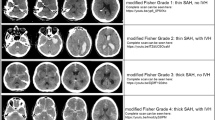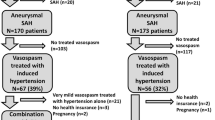Similar content being viewed by others
References
[No authors listed] (1995) Tissue plasminogen activator for acute ischemic stroke. The National Institute of Neurological Disorders and Stroke rt-PA Stroke Study Group. N Engl J Med 333: 1581–1587
Hacke W et al. (2008) Thrombolysis with alteplase 3 to 4.5 hours after acute ischemic stroke. N Engl J Med 359: 1317–1329
Clark WM et al. (1999) Recombinant tissue-type plasminogen activator (Alteplase) for ischemic stroke 3 to 5 hours after symptom onset. The ATLANTIS study: a randomized controlled trial. Alteplase Thrombolysis for Acute Noninterventional Therapy in Ischemic Stroke. JAMA 282: 2019–2026
Hacke W et al. (1995) Intravenous thrombolysis with recombinant tissue plasminogen activator for acute hemispheric stroke. The European Cooperative Acute Stroke Study (ECASS). JAMA 274: 1017–1025
Hacke W et al. (1998) Randomised double-blind placebo-controlled trial of thrombolytic therapy with intravenous alteplase in acute ischaemic stroke (ECASS II). Second European–Australasian Acute Stroke Study Investigators. Lancet 352: 1245–1251
Butcher KS et al. (2005) Refining the perfusion–diffusion mismatch hypothesis. Stroke 36: 1153–1159
Köhrmann M et al. (2006) MRI versus CT-based thrombolysis treatment within and beyond the 3 h time window after stroke onset: a cohort study. Lancet Neurol 5: 661–667
[No authors listed] (1997) Generalized efficacy of t-PA for acute stroke. Subgroup analysis of the NINDS t-PA Stroke Trial. Stroke 28: 2119–2125
Castellanos M et al. (2007) Serum cellular fibronectin and matrix metalloproteinase-9 as screening biomarkers for the prediction of parenchymal hematoma after thrombolytic therapy in acute ischemic stroke: a multicenter confirmatory study. Stroke 38: 1855–1859
Kakuda W et al. (2005) Clinical importance of microbleeds in patients receiving IV thrombolysis. Neurology 65: 1175–1178
Neumann-Haefelin T et al. (2006) Leukoaraiosis is a risk factor for symptomatic intracerebral hemorrhage after thrombolysis for acute stroke. Stroke 37: 2463–2466
McCarron M et al. (2004) Cerebral amyloid angiopathy and thrombolysis-related intracerebral haemorrhage. Lancet Neurol 3: 484–492
Author information
Authors and Affiliations
Corresponding author
Ethics declarations
Competing interests
The authors declare no competing financial interests.
Rights and permissions
About this article
Cite this article
Maulaz, A., Martins, R., de Castro Ribeiro, M. et al. Could thrombolytic approaches in acute stroke benefit from stringent selection criteria?. Nat Rev Neurol 5, 138–139 (2009). https://doi.org/10.1038/ncpneuro1048
Received:
Accepted:
Issue Date:
DOI: https://doi.org/10.1038/ncpneuro1048
- Springer Nature Limited
This article is cited by
-
Diffusion Limited Delivery of Streptokinase and tPA to a Thrombus
Cardiovascular Engineering and Technology (2013)





